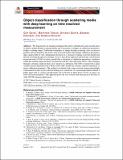Object classification through scattering media with deep learning on time resolved measurement
Author(s)
Satat, Guy; Tancik, Matthew; Gupta, Otkrist; Heshmat, Barmak; Raskar, Ramesh
DownloadPublished version (10.19Mb)
Terms of use
Metadata
Show full item recordAbstract
© 2017 Optical Society of America. We demonstrate an imaging technique that allows identification and classification of objects hidden behind scattering media and is invariant to changes in calibration parameters within a training range. Traditional techniques to image through scattering solve an inverse problem and are limited by the need to tune a forward model with multiple calibration parameters (like camera field of view, illumination position etc.). Instead of tuning a forward model and directly inverting the optical scattering, we use a data driven approach and leverage convolutional neural networks (CNN) to learn a model that is invariant to calibration parameters variations within the training range and nearly invariant beyond that. This effectively allows robust imaging through scattering conditions that is not sensitive to calibration. The CNN is trained with a large synthetic dataset generated with a Monte Carlo (MC) model that contains random realizations of major calibration parameters. The method is evaluated with a time-resolved camera and multiple experimental results are provided including pose estimation of a mannequin hidden behind a paper sheet with 23 correct classifications out of 30 tests in three poses (76.6% accuracy on real-world measurements). This approach paves the way towards real-time practical non line of sight (NLOS) imaging applications.
Date issued
2017Department
Massachusetts Institute of Technology. Media LaboratoryJournal
Optics Express
Publisher
The Optical Society